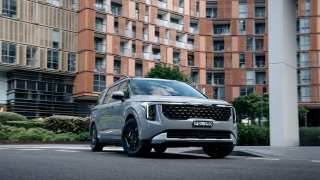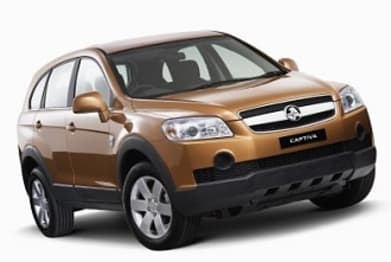
Used Holden Captiva review: 2006-2014
- Holden Captiva
- Holden Captiva 2006
- Holden Captiva 2007
- Holden Captiva 2008
- Holden Captiva 2009
- Holden Captiva 2010
- Holden Captiva 2012
- Holden Captiva 2013
- Holden Captiva 2014
- Holden Captiva 2011
- Holden Captiva Reviews
- Holden Reviews
- Holden SUV Range
- SUV
- Holden
- Used Car Reviews

Holden Captiva is a medium-large SUV that is imported from a General Motors factory in South Korea. It has a lot of Australian input in its body styling and mechanical components.
Interestingly, the Captiva is offered in two different body styles, with the Maxx having a sporty look and five seats. The others are built as five or seven-seaters.
The third row seats are larger than those in many of Captiva’s competitors but are still better suited to children than adults. It can carry adults in moderate comfort, though ideally not on long trips.
Storage space when all seven seats are in place is very restricted. This is not unusual in this class, but check for yourself if you’re planning to use all seats for people. The rear seats can the folded down in various ways, when all are flat, you have up to 1565 litres of luggage space.
There are a number of smaller stowage compartments including a large wet/dry area beneath the load compartment floor. Interior storage is excellent, with seatback pockets; a glovebox cooler; front and rear centre console storage; door bins; drink holders; and an overhead sunglasses holder
When introduced in launched in 2007 the only Captiva powerplant was a 3.2-litre V6 petrol built in Australia by Holden. The engine was shipped to the South Korean factory to be installed in Captivas used on many global markets. A 2.0-litre diesel engine was added to the range a few months later.
Initially all Captivas had a part-time 4WD system, with drive normally being to the front wheels and the rear wheels being engaged when extra traction was demanded. The 4WD system is well engineered and the Holden Captiva can tackle some quite tough off-road areas as it has good approach and departure angles.
While Holden Captiva is not a heavy-duty 4WD but can go surprisingly far in the hands of an experienced operator.
A 2WD version, driven through the front wheels, was introduced in December 2009. Called the Captiva 5 and using the Maxx style body it’s a powered by a 2.4-litre four-cylinder petrol engine.
A five-speed automatic with manual overrides was the only transmission until the arrival of the Captiva 5, which is offered with a six-speed manual as well as the automatic transmission.
The automatics were upgraded to six forward ratios with the introduction of a facelifted Captiva in February 2011.
All Captiva models come with electronic stability control, ABS brakes with brake assist, traction control, active rollover protection and descent control. There are dual front airbags in all models with side curtain airbags optional in the lower cost models and standard on the others.
Holden dealers operate in most areas of Australia and most are likely to carry the more common spare parts for the Captiva. Other components can usually be shipped in within a couple of working days. Prices are often lower than average for an imported vehicle in this class.
Parts and servicing costs are reasonable and the relatively simple layout of the Captiva means the good amateur mechanic can do a fair bit of their own work. Safety related items should only be worked on by professionals.
Insurance costs are pretty reasonable and we haven’t seen a big variation between companies. However, it’s always smart to shop around for the best deal making sure that you’re comparing apples with apples when doing so.
What to look for
Check for rust in the lower area of the body and in a Captiva that may have been used on the beach.
Look over the interior for signs of dirt having been ground into carpets. Similarly, check for damage and/or stains on the seats.
Look for off-road damage to the bumper corners, the door sills and for light scratches in the paintwork on the doors and the front guards.
If the load area has been used to cart heavy gear and/or has been damaged by poor loading and/or fastening there could be severe damage to the carpets. Again, signs of sand may be bad news.
Engines that are slow to start or blow smoke when worked hard may be due for major repairs.
Automatic transmissions that don’t go into Drive quickly when moved from Neutral or Reverse may need servicing.
Car buying tip
If living in a remote area it’s a good idea to check that trained mechanics are locally available before going too deeply into your choice of vehicle.
Pricing
| Year | Price From | Price To |
|---|---|---|
| 2014 | $6,490 | $16,610 |
| 2013 | $6,270 | $14,080 |
| 2012 | $5,500 | $12,430 |
| 2011 | $5,170 | $11,330 |
| 2010 | $4,510 | $10,120 |
| 2009 | $2,530 | $9,350 |
| 2008 | $2,310 | $9,130 |
| 2007 | $3,740 | $8,690 |
| 2006 | $4,070 | $6,820 |
Pricing guides
Range and Specs
| Vehicle | Specs | Price* | |
|---|---|---|---|
| SX (4X4) | 3.2L, ULP, 5 SP AUTO | $4,290 – 6,380 | 2006 Holden Captiva 2006 SX (4X4) Pricing and Specs |
| CX (4X4) | 3.2L, ULP, 5 SP AUTO | $4,620 – 6,820 | 2006 Holden Captiva 2006 CX (4X4) Pricing and Specs |
| Maxx (4x4) | 3.2L, ULP, 5 SP AUTO | $4,180 – 6,160 | 2006 Holden Captiva 2006 Maxx (4x4) Pricing and Specs |
| LX (4X4) | 3.2L, ULP, 5 SP AUTO | $4,070 – 6,050 | 2006 Holden Captiva 2006 LX (4X4) Pricing and Specs |
$4,620
Lowest price, based on third party pricing data







